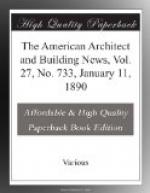THE NATURAL-GAS SUPPLY.—At the recent meeting in New York of the American Geological Society, Prof. Edward Orton, State Geologist of Ohio, and a professor in the State University, in his paper answered those who claim that the great natural gas fields of the country are practically inexhaustible, and that nature is manufacturing the gas by chemical combination in the subterranean cavities as rapidly as it is consumed by man at the surface. He claimed that the supply of natural gas in those States was not only limited, but was being exhausted very rapidly and would be drained in less than nine years. The gas, he said, is now being used as the basis of a varied line of manufactures, the annual products of which aggregate many millions of dollars, and it is driving, besides the iron and steel mills of Pittsburgh, potteries and brick works, over forty glass furnaces and a long list of factories in which cheap power is a desideratum. The gas is the product of ages, which has been accumulated in the porous limestone of Ohio and Indiana. It has been produced so slowly that when once exhausted it will take many thousands of years for it to again accumulate in sufficient quantities to be used, even if the elements necessary for its production were preserved, which he thought was not at all probable. The pressure which forces the gas out with such tremendous power that it sometimes reaches 1,000 pounds pressure per square inch, is not due to the pressure of the gas itself, but to the hydrostatic pressure brought to bear by the column of salt water that enters the porous stratum of rock containing the gas at the sea-level, and which by its weight tends to force the gas out. To the explanation and elucidation of this phenomenon, Professor Orton’s paper was more especially devoted. The men who are engaged in the practical development of gas and oil fields, said he, made great account of rock-pressure. It is the first fact they inquire after in a new gas-field. They appreciate its importance, knowing that the distance of the markets they care to reach and the size of the pipes they can employ are entirely dependent upon this element. He defined the term “rock-pressure”, and showed the decrease of its rate westward. He said four hundred thousand people in Northwestern Ohio and Central Indiana alone depended upon natural-gas for fuel and illumination.
* * * * *
STATUE GIVING A DOUBLE IMAGE.—At the Italian exhibition in the Champ de Mars there was a statue that attracted much attention from the visitors. It represented Goethe’s Marguerite standing before a mirror. This latter gave by reflection the image of Faust. The artifice was well concealed by the sculptor. In reality, it was not a double statue, but the figure of Faust was skilfully obtained by means of the folds of Marguerite’s robe.




